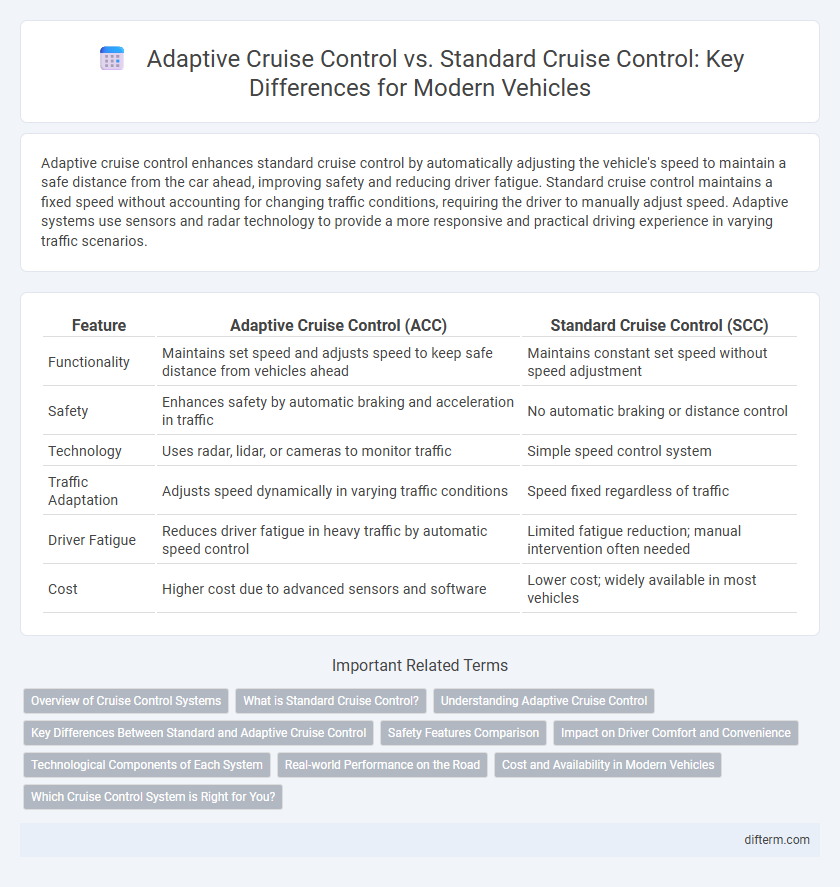Adaptive cruise control enhances standard cruise control by automatically adjusting the vehicle's speed to maintain a safe distance from the car ahead, improving safety and reducing driver fatigue. Standard cruise control maintains a fixed speed without accounting for changing traffic conditions, requiring the driver to manually adjust speed. Adaptive systems use sensors and radar technology to provide a more responsive and practical driving experience in varying traffic scenarios.
Table of Comparison
| Feature | Adaptive Cruise Control (ACC) | Standard Cruise Control (SCC) |
|---|---|---|
| Functionality | Maintains set speed and adjusts speed to keep safe distance from vehicles ahead | Maintains constant set speed without speed adjustment |
| Safety | Enhances safety by automatic braking and acceleration in traffic | No automatic braking or distance control |
| Technology | Uses radar, lidar, or cameras to monitor traffic | Simple speed control system |
| Traffic Adaptation | Adjusts speed dynamically in varying traffic conditions | Speed fixed regardless of traffic |
| Driver Fatigue | Reduces driver fatigue in heavy traffic by automatic speed control | Limited fatigue reduction; manual intervention often needed |
| Cost | Higher cost due to advanced sensors and software | Lower cost; widely available in most vehicles |
Overview of Cruise Control Systems
Adaptive cruise control (ACC) enhances standard cruise control by automatically adjusting vehicle speed to maintain a safe following distance using radar and camera sensors. Standard cruise control maintains a fixed speed set by the driver without accounting for changing traffic conditions. ACC improves driving safety and convenience, especially in varying traffic, by dynamically responding to vehicles ahead.
What is Standard Cruise Control?
Standard cruise control is a vehicle system that maintains a constant speed set by the driver without the need to keep the accelerator pressed. It provides convenience during long highway drives by reducing driver fatigue but lacks the ability to adjust speed based on surrounding traffic conditions. Unlike adaptive cruise control, standard cruise control does not use sensors to detect other vehicles and cannot automatically slow down or speed up in response to traffic flow.
Understanding Adaptive Cruise Control
Adaptive cruise control (ACC) enhances standard cruise control by automatically adjusting vehicle speed to maintain a safe following distance from the car ahead using radar and camera sensors. Unlike standard cruise control, which maintains a fixed speed regardless of traffic conditions, ACC dynamically responds to traffic flow, improving safety and reducing driver fatigue. This system is integral to advanced driver-assistance technologies and supports semi-autonomous driving features.
Key Differences Between Standard and Adaptive Cruise Control
Standard cruise control maintains a fixed speed set by the driver without adjusting for traffic conditions, while adaptive cruise control uses radar or cameras to automatically modulate speed and maintain a safe following distance. Adaptive systems enhance safety by reacting to slower vehicles ahead, reducing the need for manual braking or acceleration. This technological difference significantly improves convenience and reduces driver fatigue during varying traffic flows.
Safety Features Comparison
Adaptive cruise control enhances safety by automatically adjusting vehicle speed to maintain a safe following distance using radar and sensors, reducing collision risks. Standard cruise control maintains a fixed speed set by the driver, lacking real-time responsiveness to traffic changes. The integration of adaptive cruise control with emergency braking systems significantly improves overall road safety compared to traditional cruise control.
Impact on Driver Comfort and Convenience
Adaptive cruise control enhances driver comfort by automatically adjusting vehicle speed to maintain a safe following distance, reducing the need for constant manual speed adjustments. Standard cruise control maintains a fixed speed, requiring drivers to manually intervene in changing traffic conditions, which can increase fatigue during long drives. The adaptive system's ability to respond to traffic flow smooths the driving experience, significantly improving convenience on highways and in stop-and-go traffic.
Technological Components of Each System
Adaptive cruise control utilizes radar sensors, cameras, and advanced algorithms to automatically adjust vehicle speed based on surrounding traffic conditions. Standard cruise control relies on a simple throttle control mechanism that maintains a pre-set speed without reacting to changes in traffic. The integration of LIDAR or ultrasonic sensors in adaptive systems enhances real-time obstacle detection, providing superior safety and convenience compared to the fixed-speed functionality of standard cruise control.
Real-world Performance on the Road
Adaptive cruise control enhances real-world performance on the road by automatically adjusting vehicle speed based on traffic conditions, maintaining safe following distances, and reducing driver fatigue during long journeys. Standard cruise control maintains a fixed speed without accounting for slower vehicles or changing traffic flow, requiring constant driver input to brake or accelerate. The dynamic responsiveness of adaptive cruise control significantly improves safety and convenience in varied traffic scenarios.
Cost and Availability in Modern Vehicles
Adaptive cruise control (ACC) is generally more expensive than standard cruise control due to advanced sensors and radar technology, with prices often increasing by $500 to $2,000 depending on the vehicle model. While standard cruise control is widely available across most entry-level and mid-range vehicles, adaptive cruise control is typically found in mid to high-end models or offered as an optional upgrade package. The growing demand for safety features is driving broader availability of ACC in newer vehicles, though it remains less common in budget-friendly cars.
Which Cruise Control System is Right for You?
Adaptive cruise control uses radar and sensors to automatically adjust your vehicle's speed based on traffic conditions, enhancing safety and reducing driver fatigue during long drives. Standard cruise control maintains a consistent speed set by the driver but requires manual adjustments to respond to changing traffic. Choosing between adaptive and standard cruise control depends on your driving habits, road environments, and preference for convenience versus simplicity.
adaptive cruise control vs standard cruise control Infographic

 difterm.com
difterm.com